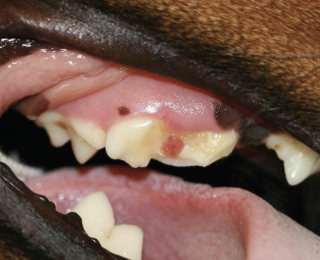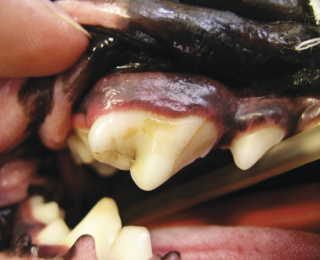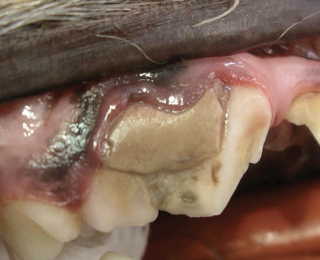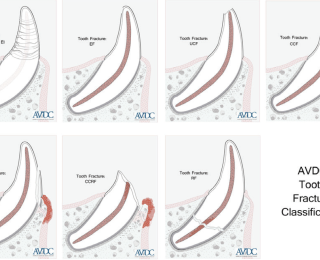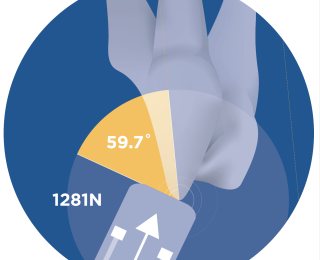Focus - December 2019
Exploring tooth-fracture risks in canine patients
Lisa Milella BVSc DipEVDC MRCVS, discusses studies into the forces that a dog’s teeth can withstand when chewing, and the likelihood of dental injury
ooth fracture in dogs is a commonly observed clinical condition, with a reported prevalence of 20% to 27% although many owners may not even be aware their pet has a fractured tooth.
In maxillofacial trauma patients, the reported prevalence of tooth fracture is even higher (67 % to 85 %). Tooth fractures often occur as a result of traumatic impacts, such as road traffic collisions or direct trauma to the mouth, but an increasing concern exists about the potential role of chewing on treats and toys in the fracture of large cheek teeth. Tooth fractures have been reported to occur most commonly in functionally important teeth that play a role in prehension and chewing – namely, the canine and carnassial teeth.1-6
Tooth fractures may be uncomplicated – involving just the enamel and/or dentine – or complicated, which involves the pulp cavity, too. This is clinically important as the pulp cavity contains blood and lymph vessels, nerves, odontoblasts and connective tissue, which, when exposed, become inflamed, resulting in pulpitis and may, ultimately, lead to pulp necrosis.
Pulpitis in the acute stages results in sharp pain, and in the chronic stages, results in dull, throbbing pain. It is often only after treatment that we can appreciate the pain the pet was suffering by the notable changes in its behaviour.
Clinically, a tooth with a recent complicated crown fracture will have a pink or red spot, indicating pulp exposure, and if the pulp has started to become necrotic, the pulp will be a black colour (Figures 1-3). All these teeth require treatment, either extraction or endodontic treatment (root canal therapy) if suitable.7,8
Chewing behaviours
As well as clinical treatment, it is also advisable to question the owner about potentially damaging chewing behaviours. While chew products can be a good way to help maintain a dog’s oral hygiene, not all chews would be considered safe. A letter from veterinary dentists to the Veterinary Times editor a few years ago highlighted concerns about the increase in the number of fractured teeth seen following dogs chewing on antlers or nylon bones.9
The general guidelines have always been that a dog should not chew on anything hard that cannot bend or break when in contact with teeth, or anything that cannot be indented with your thumbnail.
While expert opinion is valuable, it is the lowest form of evidence and, for a number of years, independent veterinary dentists have expressed their concerns to the industry regarding unsafe products, requesting more evidence-based research exploring the relationship of chew structural properties and tooth fracture be performed.
Forces
Most reported studies relating to chews have investigated the role of them in the maintenance of oral hygiene, looking at their effect on factors affecting periodontal disease rather than specifically potential trauma to teeth.10
Until now, the role of chewing activity in the development of tooth fractures in dogs had been controversial – in part, due to the lack of information available about the resilience of teeth to masticatory forces and the impact of the treat or toy’s textural properties in transmitting a potentially harmful stress concentration through the teeth.
In addition, stress distribution on functionally important teeth during chewing activity had not been evaluated.11 This meant no limits existed for the textural properties. The Veterinary Oral Health Council had no formal recommendations regarding the textural properties or hardness of chews, food or toys.12,13
Voluntary bite
Early studies showed dogs could generate voluntary bite forces ranging from 13 newtons (N) to 1,394N when working, and the forces were shown to be directly proportional to their size. When all four canine teeth are involved, the maximum pulling force can range from 480N to 1,200N.
It is also known from modelling and stimulated chewing under anaesthesia that the maximum potential bite forces for dogs can be significantly higher, peaking at more than 3,400N at molar teeth. We do not know, however, what forces dogs would actually use when chewing voluntarily.14-18
Fracture resistance
Since then, one study looked at the fracture resistance of canine teeth and showed when a force was applied to the canine tooth at a 45° angle in a direction from the occlusal surface, the maximum force the tooth could sustain before fracturing was between 494N and 630N depending on the crown height to diameter ratio.19
A more recent study conducted at the University of Pennsylvania confirmed dogs’ teeth will, indeed, fracture if they chew on a product that is too hard. The research investigated exactly what external forces were required to cause tooth fracture to the maxillary carnassial teeth.
Sample teeth with surrounding gingiva and alveolar bone were harvested from cadavers and set in polymethyl methacrylate. A force using a stainless-steel rod was applied to the cusp of the tooth at an angle set at 60°. This angle was chosen as a preliminary study showed that forces applied at an angle between 50° and 70° gave a fracture pattern most consistent with fractures seen in clinical practice and those described by the American Veterinary Dental College (Figure 4).
The point of contact of the force on the tooth used tried to mimic that of contact during normal chew behaviour. The force was increased until the point of failure. The highest compressive force prior to failure was considered to be the maximum load sustained by the tooth.
Results showed the mean maximum load sustained by the maxillary carnassial teeth tested at the point of fracture was 1,281N at a mean impact angle of 59.7°. The most common fracture type that occurred among all samples was a complicated crown fracture, followed by an uncomplicated crown fracture20 (Figure 5).
Other factors
These studies, though, were conducted on sample teeth and only mimic what occurs when chewing. Other factors – for example, pulp vitality and the periodontal ligament – play a role in fracture resistance in vivo. The periodontal ligament not only supports the tooth, but also – through its proprioceptive properties – adapts while chewing, protecting the tooth and acting as a shock absorber to some of the forces21,22.
The mean maximum force sustained by the teeth in the aforementioned studies prior to fracture, however, was within the maximum chewing capability of the average dog, raising the concern dogs that chew on treats and toys that do not yield significantly below the failure rates described earlier might be at increased risk of tooth fracture. This is of particular concern to the maxillary fourth premolar teeth as a result of overexertion during chewing.
Conclusion
In conclusion, any chew or toy that does not break under the maximum load reported may have the potential to cause tooth fracture. This research will hopefully be adopted by the industry as it proves what the maximum load is that a tooth can sustain and should be used in future to assess products to determine whether they are likely to cause a tooth fracture.
Client education is also important as many dog owners are unaware of the incidence of tooth fractures, as well as the potential harm of some chewing behaviour or products, and the impact and discomfort it may cause their pet.
The veterinary profession too should not be complacent in treating fractured teeth. Just because the dog is coping and not showing signs of pain does not mean these teeth can be monitored or ignored – any tooth with pulp exposure needs treatment.
This article was originally published in Veterinary Times, May 2019.
Biography
Lisa Milella is a European specialist in veterinary dentistry and a trustee of International Animal Rescue. Since first becoming involved with the charity in 2005, when she operated on a dozen rescued dancing bears in India, Lisa has performed dental surgery on numerous exotic animals in its care, including an orangutan.
















